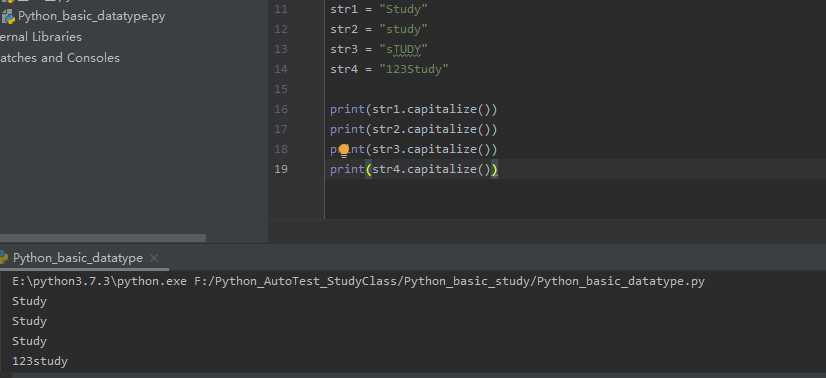标签:次数 cas 返回值 统计 语法 span 方法 max png
1、capitalize()方法
将字符串的首字母转换为大写,其他字母为小写 ,首字符如果是非字母,首字母不会转换成大写,会转换成小写
用法str.capitalize()

2、swapcase()方法
将大写字母转换为小写字母,将小写字母转换为大写字母
用法:str.swapcase()
str1 = "Study"
str2 = "study"
str3 = "sTUDY"
str4 = "123Study"
print(str1.swapcase())
print(str2.swapcase())
print(str3.swapcase())
print(str4.swapcase())

3、replace()方法
replace() 方法把字符串中的 old(旧字符串) 替换成 new(新字符串),如果指定第三个参数max,则替换不超过 max 次。
语法:replace(old, new[, max])
str5 = "There is example,There is example,There is example,There is example"
print(str5.replace("is", "was", 3))

4、find()方法与rfind()方法
从左至右查找字符串中是否包含子字符串,如果指定开始(beg)和结束(end)范围,则检查是否包含在指定范围内,如果指定范围内如果包含指定索引值,返回的是索引值在字符串中的起始位置。如果不包含索引值,返回-1。
语法:str.find(str, beg=0, end=len(string))
str -- 指定检索的字符串
beg--开始索引位置,默认为0
end--结束索引,默认为字符串的长度
str5 = "There is example,There is example,There is example,There is example"
str6 = "is"
print(str5.find(str6, 0, 5))
print(str5.find(str6, 5))
print(str5.find(str6, 10))

rfind()方法 :与find()方法类似,返回字符串最后一次出现的位置,如果没有匹配项则返回-1。 rfind()方法是从右侧开始查找
5、count()方法
用于统计字符串中某字符出现的次数,可选参数为字符串搜索的开始位置和结束位置
返回值:该方法返回子字符串在字符串中出现的次数
语法:str.count(sub,start =0 ,end = len(string))
sub:搜索的子字符串
start:字符串开始搜索的位置。默认为第一个字符,第一个字符索引值为0。
end:字符串中结束搜索的位置。字符中第一个字符的索引为 0。默认为字符串的最后一个位置
str5 = "There is example,There is example,There is example,There is example"
sub = "is"
print(str5.count(sub))
print(str5.count(sub, 0, 5,))

标签:次数 cas 返回值 统计 语法 span 方法 max png
原文地址:https://www.cnblogs.com/keepkeep/p/11570460.html